Longfei Shangguan
Map++: Towards User-Participatory Visual SLAM Systems with Efficient Map Expansion and Sharing
Nov 04, 2024



Abstract:Constructing precise 3D maps is crucial for the development of future map-based systems such as self-driving and navigation. However, generating these maps in complex environments, such as multi-level parking garages or shopping malls, remains a formidable challenge. In this paper, we introduce a participatory sensing approach that delegates map-building tasks to map users, thereby enabling cost-effective and continuous data collection. The proposed method harnesses the collective efforts of users, facilitating the expansion and ongoing update of the maps as the environment evolves. We realized this approach by developing Map++, an efficient system that functions as a plug-and-play extension, supporting participatory map-building based on existing SLAM algorithms. Map++ addresses a plethora of scalability issues in this participatory map-building system by proposing a set of lightweight, application-layer protocols. We evaluated Map++ in four representative settings: an indoor garage, an outdoor plaza, a public SLAM benchmark, and a simulated environment. The results demonstrate that Map++ can reduce traffic volume by approximately 46% with negligible degradation in mapping accuracy, i.e., less than 0.03m compared to the baseline system. It can support approximately $2 \times$ as many concurrent users as the baseline under the same network bandwidth. Additionally, for users who travel on already-mapped trajectories, they can directly utilize the existing maps for localization and save 47% of the CPU usage.
LLM-dCache: Improving Tool-Augmented LLMs with GPT-Driven Localized Data Caching
Jun 10, 2024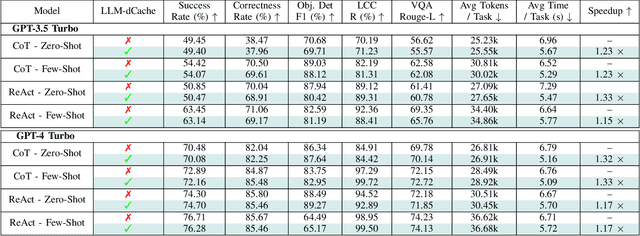


Abstract:As Large Language Models (LLMs) broaden their capabilities to manage thousands of API calls, they are confronted with complex data operations across vast datasets with significant overhead to the underlying system. In this work, we introduce LLM-dCache to optimize data accesses by treating cache operations as callable API functions exposed to the tool-augmented agent. We grant LLMs the autonomy to manage cache decisions via prompting, seamlessly integrating with existing function-calling mechanisms. Tested on an industry-scale massively parallel platform that spans hundreds of GPT endpoints and terabytes of imagery, our method improves Copilot times by an average of 1.24x across various LLMs and prompting techniques.
Saiyan: Design and Implementation of a Low-power Demodulator for LoRa Backscatter Systems
Sep 30, 2022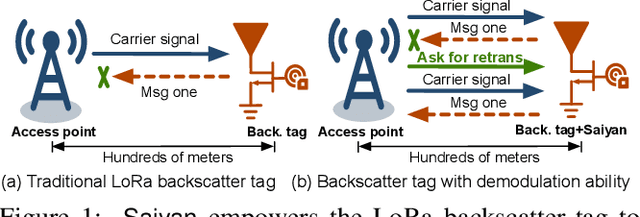
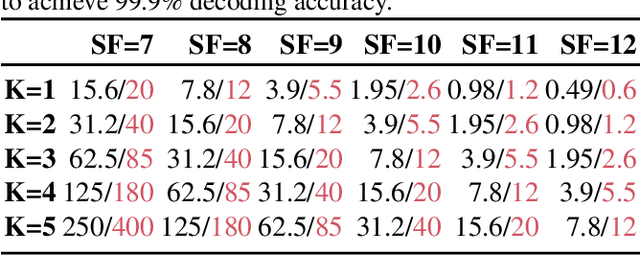
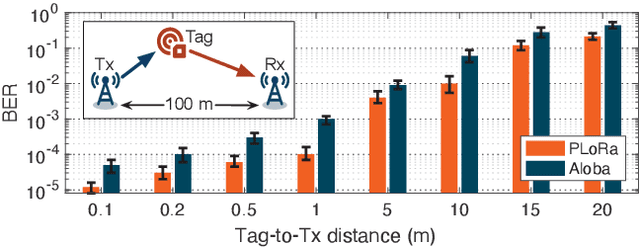

Abstract:The radio range of backscatter systems continues growing as new wireless communication primitives are continuously invented. Nevertheless, both the bit error rate and the packet loss rate of backscatter signals increase rapidly with the radio range, thereby necessitating the cooperation between the access point and the backscatter tags through a feedback loop. Unfortunately, the low-power nature of backscatter tags limits their ability to demodulate feedback signals from a remote access point and scales down to such circumstances. This paper presents Saiyan, an ultra-low-power demodulator for long-range LoRa backscatter systems. With Saiyan, a backscatter tag can demodulate feedback signals from a remote access point with moderate power consumption and then perform an immediate packet retransmission in the presence of packet loss. Moreover, Saiyan enables rate adaption and channel hopping-two PHY-layer operations that are important to channel efficiency yet unavailable on long-range backscatter systems. We prototype Saiyan on a two-layer PCB board and evaluate its performance in different environments. Results show that Saiyan achieves 5 gain on the demodulation range, compared with state-of-the-art systems. Our ASIC simulation shows that the power consumption of Saiyan is around 93.2 uW. Code and hardware schematics can be found at: https://github.com/ZangJac/Saiyan.
Efficient Ambient LoRa Backscatter with On-Off Keying Modulation
Sep 30, 2022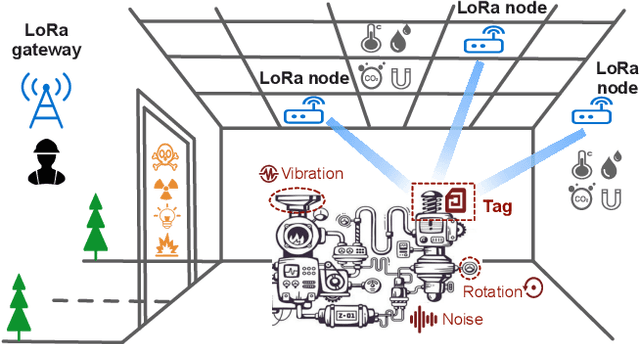
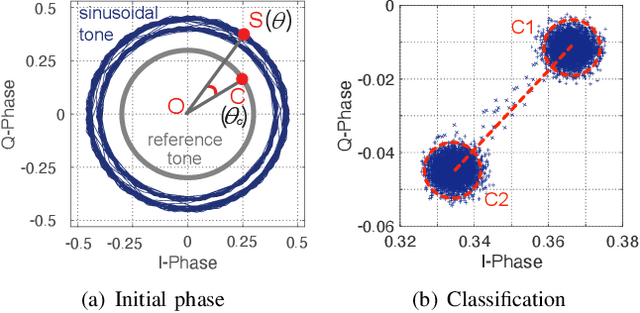
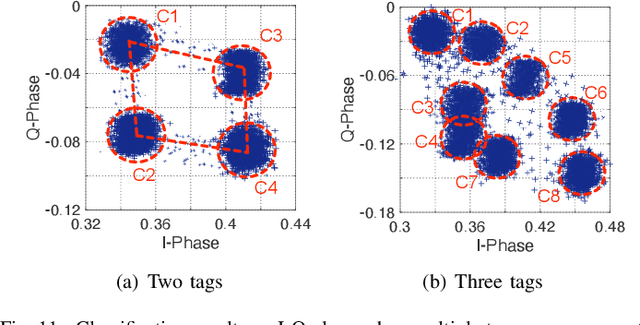
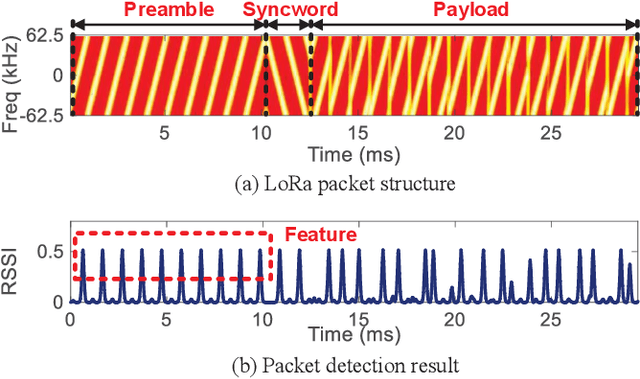
Abstract:Backscatter communication holds potential for ubiquitous and low-cost connectivity among low-power IoT devices. To avoid interference between the carrier signal and the backscatter signal, recent works propose a frequency-shifting technique to separate these two signals in the frequency domain. Such proposals, however, have to occupy the precious wireless spectrum that is already overcrowded, and increase the power, cost, and complexity of the backscatter tag. In this paper, we revisit the classic ON-OFF Keying (OOK) modulation and propose Aloba, a backscatter system that takes the ambient LoRa transmissions as the excitation and piggybacks the in-band OOK modulated signals over the LoRa transmissions. Our design enables the backsactter signal to work in the same frequency band of the carrier signal, meanwhile achieving flexible data rate at different transmission range. The key contributions of Aloba include: (1) the design of a low-power backscatter tag that can pick up the ambient LoRa signals from other signals. (2) a novel decoding algorithm to demodulate both the carrier signal and the backscatter signal from their superposition. We further adopt link coding mechanism and interleave operation to enhance the reliability of backscatter signal decoding. We implement Aloba and conduct head-to-head comparison with the state-of-the-art LoRa backscatter system PLoRa in various settings. The experiment results show Aloba can achieve 199.4 Kbps data rate at various distances, 52.4 times higher than PLoRa.
RF-Transformer: A Unified Backscatter Radio Hardware Abstraction
Sep 30, 2022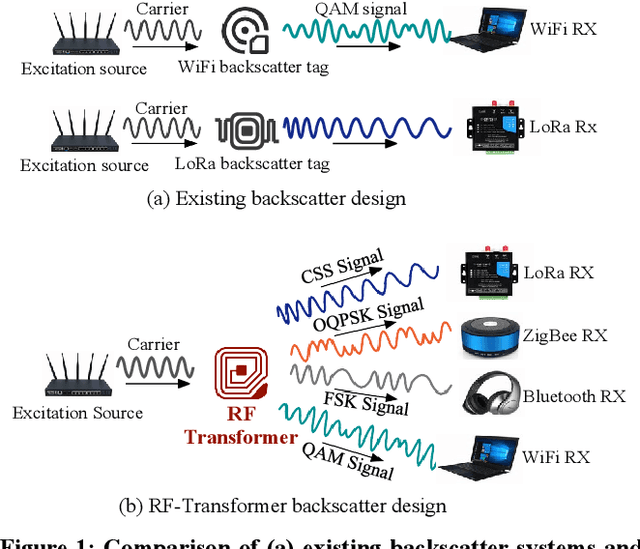
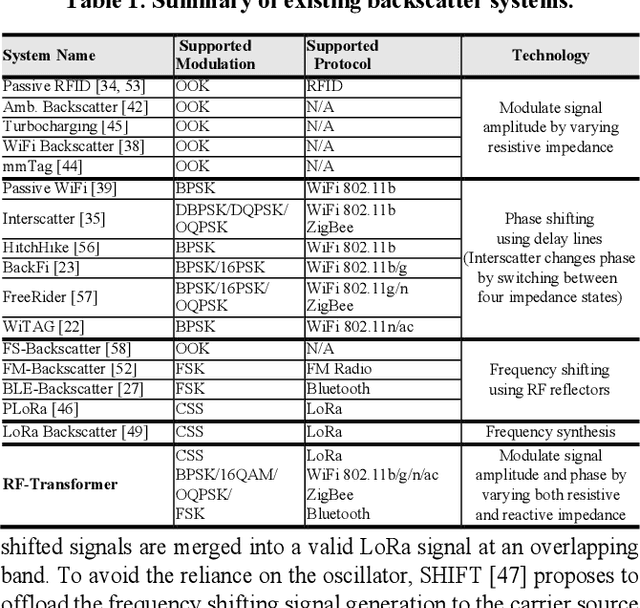
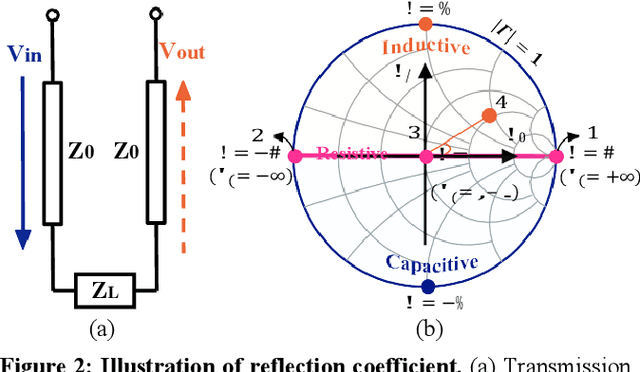

Abstract:This paper presents RF-Transformer, a unified backscatter radio hardware abstraction that allows a low-power IoT device to directly communicate with heterogeneous wireless receivers at the minimum power consumption. Unlike existing backscatter systems that are tailored to a specific wireless communication protocol, RF-Transformer provides a programmable interface to the micro-controller, allowing IoT devices to synthesize different types of protocol-compliant backscatter signals sharing radically different PHY-layer designs. To show the efficacy of our design, we implement a PCB prototype of RF-Transformer on 2.4 GHz ISM band and showcase its capability on generating standard ZigBee, Bluetooth, LoRa, and Wi-Fi 802.11b/g/n/ac packets. Our extensive field studies show that RF-Transformer achieves 23.8 Mbps, 247.1 Kbps, 986.5 Kbps, and 27.3 Kbps throughput when generating standard Wi-Fi, ZigBee, Bluetooth, and LoRa signals while consuming 7.6-74.2 less power than their active counterparts. Our ASIC simulation based on the 65-nm CMOS process shows that the power gain of RF-Transformer can further grow to 92-678. We further integrate RF-Transformer with pressure sensors and present a case study on detecting foot traffic density in hallways. Our 7-day case studies demonstrate RFTransformer can reliably transmit sensor data to a commodity gateway by synthesizing LoRa packets on top of Wi-Fi signals. Our experimental results also verify the compatibility of RF-Transformer with commodity receivers. Code and hardware schematics can be found at: https://github.com/LeFsCC/RF-Transformer.
A Survey of Large-Scale Deep Learning Serving System Optimization: Challenges and Opportunities
Nov 28, 2021



Abstract:Deep Learning (DL) models have achieved superior performance in many application domains, including vision, language, medical, commercial ads, entertainment, etc. With the fast development, both DL applications and the underlying serving hardware have demonstrated strong scaling trends, i.e., Model Scaling and Compute Scaling, for example, the recent pre-trained model with hundreds of billions of parameters with ~TB level memory consumption, as well as the newest GPU accelerators providing hundreds of TFLOPS. With both scaling trends, new problems and challenges emerge in DL inference serving systems, which gradually trends towards Large-scale Deep learning Serving systems (LDS). This survey aims to summarize and categorize the emerging challenges and optimization opportunities for large-scale deep learning serving systems. By providing a novel taxonomy, summarizing the computing paradigms, and elaborating the recent technique advances, we hope that this survey could shed light on new optimization perspectives and motivate novel works in large-scale deep learning system optimization.
 Add to Chrome
Add to Chrome Add to Firefox
Add to Firefox Add to Edge
Add to Edge